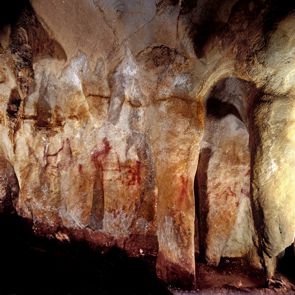Speleothem chronology
Small calcite samples (about 20 mg) taken along the growth axis of a stalagmite can be dated by MC-ICPMS. Using the StalAge code,
designed by me and Denis Scholz, an age model can be interpolated between dated points, as shown for the stalagmite SC-06-01 from
Libya (Hoffmann et al., 2016). The red lines show position of red layers in the stalagmites which indicate red dust deposition.
In some cases the red line is accompanied by a growth hiatus (solid red line). The stalagmite formed in a cave that is dry today
and the growth phases indicate times with more water in the cave and therefore more effective rain fall.

Speleothem research
Stalagmites like SC-06-01 can be used to investigate past climate conditions and changes. This stalagmite shows three main growth phases during the last glacial period. It was previously unknown that north Africa experienced wet phases during this time period. Stable oxygen isotopes show a high degree of coherence with Greenland ice core NGRIP which indicates a north Atlantic influence on north African rainfall during the last glacial period. The 18O values exclude that the African monsoon is responsible for the rainfall. The wet phases are possible related to modern human migration that happened during the last glacial period (Hoffmann et al., 2016).


